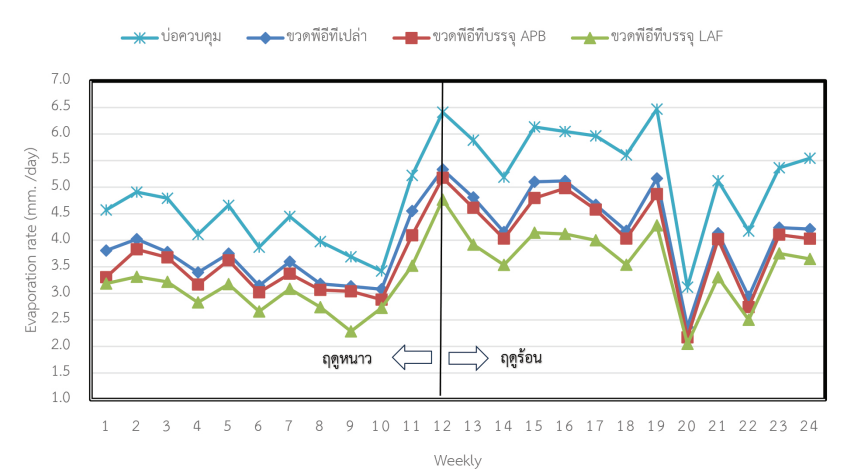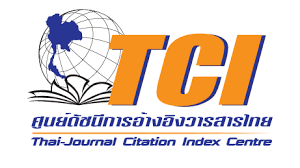Efficiency in Reducing Evaporation of Water Sources by Using PET Bottles Containing Plastic Scraps
Keywords:
Evaporation Reduction, Drought, PET Bottles, Waste ReuseAbstract
Background and Objectives: Evaporation is one of the causes of water loss from agricultural storage ponds. The costly method of covering up storage ponds makes it impossible for smallholder farmers to implement. This article presents a method of using polyethylene terephthalate (PET) bottles filled with an opaque material floating on the water surface to reduce evaporation loss. The filled opaque materials were Laminated Aluminum Foil (LAF) and Assorted Plastic Bags (APB).
Methodology: The experiments were performed using 4 experimental ponds and 1 evaporation pan. The water level was measured on a daily basis to record the evaporation rate. One experimental pond and the standard Class-A pan were used as controls. The remaining three ponds were covered with empty PET bottles, bottles filled with LAF and bottles filled with APB. The water surface temperature was measured. The cost-effectiveness of each scheme was then analyzed using the Incremental Cost-Effectiveness Ratio (ICER) method.
Main Results: The experiment results showed that evaporation decreased by 19.2%, 23.2% and 32.3% respectively, while the average water surface temperatures were 29.8 ºC, 28.9 ºC, and 28.6 ºC, respectively, in the cases of the ponds covered with empty PET bottles, LAF-filled PET bottles and APB-filled PET bottles. The control pond exhibited an average surface water temperature of 27.7 ºC. The ICER values for the empty PET bottles, LAF-filled PET bottles and APB-filled PET bottles were calculated to be 34, 107, and 322 THB per unit of evaporation suppression efficiency, respectively.
Conclusions: LAF-filled PET bottles demonstrated the highest evaporation suppression efficiency and resulted in the lowest water surface temperature among the covered ponds. Regarding the ICER, the empty PET bottles exhibited the lowest value. If one aims to enhance the evaporation suppression efficiency of empty PET bottles, LAF-filled PET bottles present an attractive option, as they have a lower ICER value compared to APB-filled PET bottles.
Practical Application: This method can be employed as an alternative for reducing evaporation in small agricultural or community water sources.
References
Rittima, A., Saleekij, K., Samarnwongrak, K., Sritamma, P., Cheeranoravanich, I. and Udomthara, M., 2013, “The Study on Evaporation Losses from Medium and Small Reservoirs in Thailand,” Engineering Research and Development Journal, 24 (1), pp. 27-36.
Kongborriak, P. and Suebsak, K., 2010, “Evaporation in Thailand Period 10 Year (2001–2010),” Proceedings of Academic Works in Meteorology, 30 September 2011, Ministry of Information and Communication Technology, Bangkok, pp. 30-38. (In Thai).
Settakhumpoo, J. and Benjaoran, V., 2021, “Comparing the Cost Efficiencies of Traditional Evaporation Reduction with PET Bottles Containing Plastic Waste,” Engineering Journal Chiang Mai University, 28 (2), pp. 42-54.
Hunter, K., Finn, N. and Barnes, S., 2007, “The Benefits of Shade-Cloth Covers for Potable Water Storages,” Proceeding of 70th Annual Water Industry Engineers and Operators Conference, Bendigo Exhibition Centre, Australia, Vol.4, pp. 86-92.
Helfer, F., Zhang, H. and Lemckert, C., 2010, “Evaporation Reduction by Windbreaks: Overview, Modelling and Efficiency,” Urban Water Security Research Alliance, Technical Report No.16.
Verlee, D. and Zetland, D., 2015, “Extending Water Supply by Reducing Reservoir Evaporation: A Case Study from Wichita Falls, Texas,” Proceedings of Mine Water Solutions in Extreme Environments, 12-15 April 2015, Vancouver, Canada, pp. 1-10.
Saggaï, S. and Bachi, O., 2018, “Evaporation Reduction from Water Reservoirs in Arid Lands Using Monolayers: Algerian Experience,” Water Resources, 45 (2), pp. 280-288.
Elsebaie, I.H., Fouli, H. and Amin, M., 2017, “Evaporation Reduction from Open Water Tanks Using Palm-Frond Covers: Effects of Tank Shape and Coverage Pattern,” KSCE Journal of Civil Engineering, 21 (7), pp. 2977-2983.
Rezazadeh, A., Akbarzadeh, P. and Aminzadeh, M., 2020, “The Effect of Floating Balls Density on Evaporation Suppression of Water Reservoirs in the Presence of Surface Flows,” Journal of Hydrology, 591, 125323.
Han, K.W., Shi, K.B. and Yan, X.J., 2020, “Evaporation Loss and Energy Balance of Agricultural Reservoirs Covered with Counterweighted Spheres in Arid Region,” Agricultural Water Management, 238, 106227.
Li, C.L., Shi, K.B., Yan, X.J. and Jiang, C.L., 2021, “Experimental Analysis of Water Evaporation Inhibition of Plain Reservoirs in Inland Arid Area with Light Floating Balls and Floating Plates in Xinjiang, China,” Journal of Hydrologic Engineering, 26 (2), 8 p. https://doi.org/10.1061/(ASCE)HE.1943-5584.0002032
Lehmann, P., Aminzadeh, M. and Or, D., 2019, “Evaporation Suppression from Water Bodies Using Floating Covers: Laboratory Studies of Cover Type, Wind, and Radiation Effects,” Water Resources Research, 55 (6), pp. 4839-4853.
Chaudhari, N. and Chaudhari, N.D., 2015, “Use of Thermocal Sheet as Floating Cover to Reduce Evaporation Loss in Farm Pond," HYDRO 2015 INTERNATIONAL 20th International Conference on Hydraulics, Water Resources and River Engineering, 17-19 December 2015, IIT Roorkee, India, pp. 17-19.
Yao, X., Zhang, H., Lemckert, C., Brook, A. and Schouten, P., 2010, “Evaporation Reduction by Suspended and Floating Covers: Overview, Modelling and Efficiency,” Urban Water Security Research Alliance Technical Report, Vol. 28, pp. 1-13.
Youssef, Y.W. and Khodzinskaya, A., 2019, “A Review of Evaporation Reduction Methods from Water Surfaces,” E3S Web of Conferences, 97 (05044), 10 p. https://doi.org/10.1051/e3sconf/20199705044
Simon, K., Shanbhag, R. and Slocum, A., 2016, “Reducing Evaporative Water Losses from Irrigation Ponds Through the Reuse of Polyethylene Terephthalate Bottles,” Journal of Irrigation and Drainage Engineering, 142 (2), p. 06015005.
Boonyatharokul, W., 1975, “Estimation of Potential Evapotranspiration in Thailand by Using Formulas Based on Climatological Data,” Agriculture and Natural Resources, 9 (1), pp. 26-34.
Assouline, S., Narkis, K. and Or, D., 2011, “Evaporation Suppression from Water Reservoirs: Efficiency Considerations of Partial Covers,” Water Resources Research, 47 (7), pp. 1-8.
Gerdruang, A., 2015, “Cost-Effectiveness Analysis for Public Policy Evaluation,” University of the Thai Chamber of Commerce Journal Humanities and Social Sciences, 35 (2), pp. 174-184

Downloads
Published
How to Cite
Issue
Section
License
Copyright (c) 2024 King Mongkut's University of Technology Thonburi

This work is licensed under a Creative Commons Attribution-NonCommercial-NoDerivatives 4.0 International License.
Any form of contents contained in an article published in Science and Engineering Connect, including text, equations, formula, tables, figures and other forms of illustrations are copyrights of King Mongkut's University of Technology Thonburi. Reproduction of these contents in any format for commercial purpose requires a prior written consent of the Editor of the Journal.




